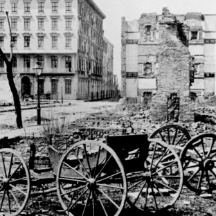On the first day of January 1808, a new federal law took effect that provided that no new slaves would be imported into the United States but Charleston hardly noticed for at nearly the same time, a "robust" slave trade was building up in the southwestern states in the years leading up to the Civil War.
Charleston, founded in 1670, wore the accumulated wealth of the blood trade very well: on its cobblestone streets stood Greek Revival storefronts, as well as Federal, Georgian, and Colonial palaces alongside Gothic houses of worship. So many churches, in fact, that one of Charleston's nicknames was "Holy City."
Many residents and visitors showed great pride in the 19 wharves that lined the Cooper River stretching some two miles or more. Charleston had become the hub of southern Atlantic commerce and one of the region's foremost ports. There was little discussion permitted that its opulence was built on and sustained by an army of Black bodies robbed of life, liberty, or the pursuit of happiness.
The Civil War began in Charleston in 1861, and its fall came only a few months before the end of the war itself in 1865. The city had been subjected to near constant Union bombardment and a series of fires that began in the first year of the conflict which destroyed hundreds of buildings.
Amos Gadsden, a former enslaved person, claimed that an early fire was started by a Union balloon while Union and rebel forces were camped on opposite sides of the river. The mayor surrendered the city to northern troops. The first of whom to enter were men of African descent of the 21st Regiment, US Colored Troops and the 55th Regiment of Massachusetts Volunteers, another Black unit. As they passed through, they sang "John Brown's Body." They were followed by scores of gleeful Black folks openly singing, praying, and shouting, beyond elated that freedom had finally come.
From Gadsden's Wharf, USA to Valongo Wharf, Brazil - Part 2 of 4 -
The Fall of Charleston and The Rise of Freedom
The Fall of Charleston and The Rise of Freedom
Praising the Past


A visiting northern journalist described Charleston as " a city of ruins, of desolation, of vacant houses...rotting wharves, of deserted warehouses...." As to the true causes of the fires, Whites told the reporter they did not know how they started. An old ex-slave, however, told him that the hand of God was in the flames, man's hand had been put to God's purpose. Again and again, in public, Black Charlestonians made it clear they were not going to maintain the prewar social order. In the spring of 1865, they cleaned up and built a fence to protect the Union burial ground. The commemorations of the "Martyrs of the Race Course" are the true root of what has come to be known as Memorial Day.
The following month, they observed the Fourth of July by honoring their new birth of freedom. Before the end of the year, they celebrated the anniversary of emancipation in Great Britain. And they began to form Black political organizations.
The horrors of Gadsden's Wharf passed into "relative obscurity" no doubt lubricated by the convenient amnesia of the city's leadership so as not to dwell on the unpleasantness of the past. But they had likely never heard of the African proverb "the axe forgets but the tree remembers." Horror such as this has many faces and names. suppressed in one place, it often oozes up in another.
Note:
The International African American Museum sits on the former site of Gadsden Wharf in downtown Charleston. It is expected to open the weekend of January 21, 2023
Part 1 - From Gadsden's Wharf, USA to Valongo Wharf, Brazil -
Coming:
Part 3 - Blood on The Palm Trees
Part 4 - In Memory and Healing
The following month, they observed the Fourth of July by honoring their new birth of freedom. Before the end of the year, they celebrated the anniversary of emancipation in Great Britain. And they began to form Black political organizations.
The horrors of Gadsden's Wharf passed into "relative obscurity" no doubt lubricated by the convenient amnesia of the city's leadership so as not to dwell on the unpleasantness of the past. But they had likely never heard of the African proverb "the axe forgets but the tree remembers." Horror such as this has many faces and names. suppressed in one place, it often oozes up in another.
Note:
The International African American Museum sits on the former site of Gadsden Wharf in downtown Charleston. It is expected to open the weekend of January 21, 2023
Part 1 - From Gadsden's Wharf, USA to Valongo Wharf, Brazil -
Coming:
Part 3 - Blood on The Palm Trees
Part 4 - In Memory and Healing
Advertisers | Contact Us | Events | Links | Media Kit | Our Company | Payments Pier
Press Room | Print Cover Stories Archives | Electronic Issues and Talk Radio Archives | Writer's Guidelines






